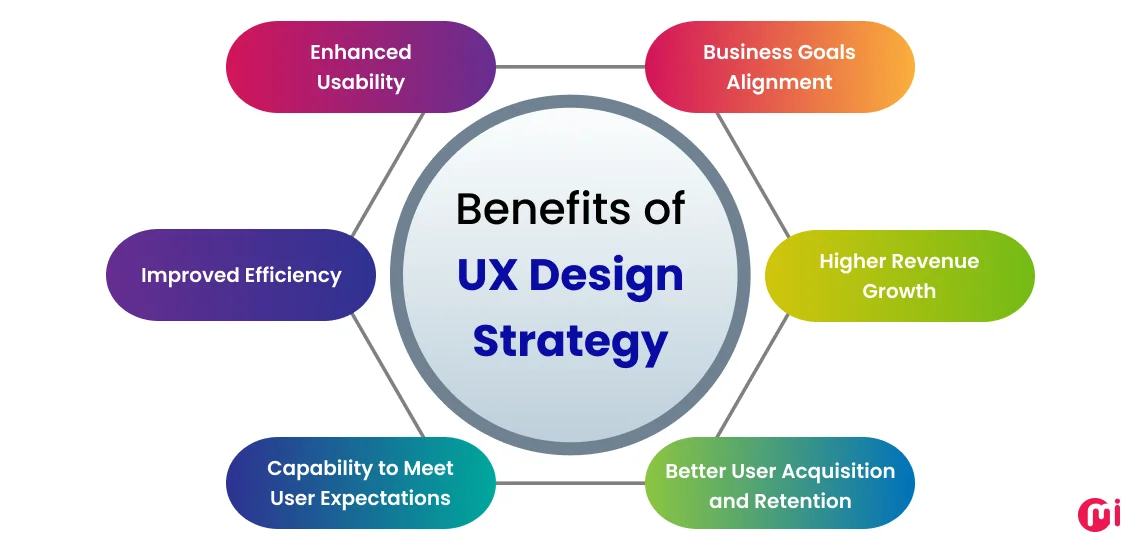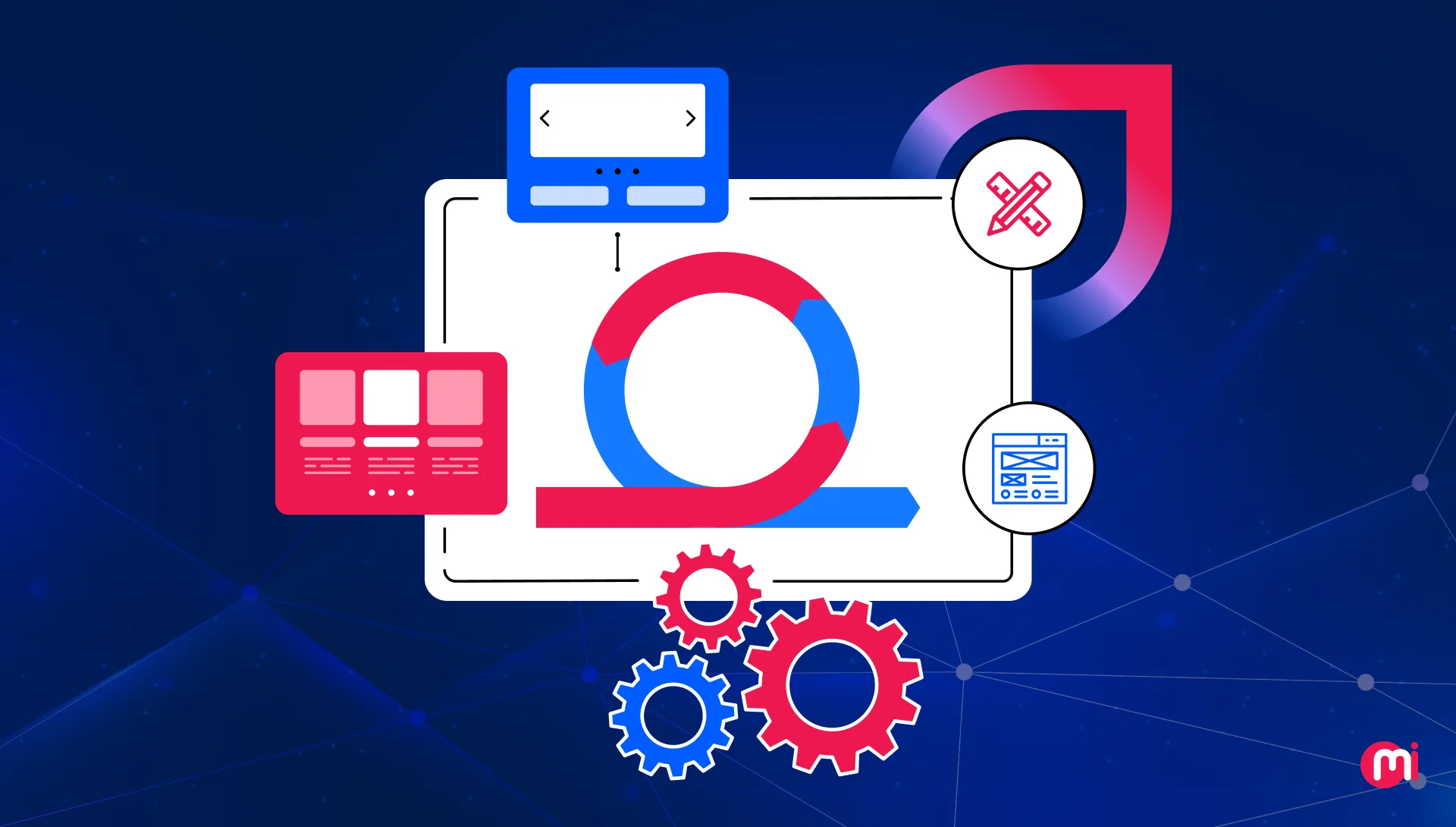How UX Design Strategy Can Make Your Software Successful?
- UI/UX
- January 7, 2025
An impeccable UX design strategy can transform your software into a user-friendly, efficient, and successful product. By aligning user needs with business goals, it ensures intuitive designs, improved usability, and a seamless experience that keeps users engaged. This blog on UX design strategy explores the benefits, key components of UX strategy, design process, and associated risks, showing how they drive user satisfaction, retention, and business growth.
Why does some software become widely popular while others barely generate income, even if they offer similar features? So, what’s the secret behind these apps and why do their users keep coming for more? The answer often lies in their user experience (UX) design strategy—it turns a functional product into something users genuinely love.
As Steve Jobs famously said, “Design is not just what it looks like and feels like. Design is how it works.” A solid UX design strategy embodies this idea, focusing on creating software that isn’t just functional but also intuitive and enjoyable to use.
Companies that prioritise user experience design strategy formation don’t just create better software—they create loyal customers. But here’s the big question: how do you design software with an impeccable UX strategy that works for your users and not against them? And why is UX design strategy important for your software’s success?
This blog explores the significance of UX design strategy and how it can transform your software into something users love—and how that love translates into growth, loyalty, and success for your business. Let’s get started!

Key Benefits of Developing a UX Design Strategy
For every dollar invested in UX design strategy formation, businesses see a remarkable return of $100—an impressive ROI of 9,900%. Moreover, an optimized User Experience (UX) design strategy can boost website conversion rates by up to 400%. These UI UX statistics prove the importance of having an impactful UX design that differentiates the software in the market.
A well-defined user experience strategy brings numerous advantages that can enhance both user experience and business outcomes of the software. Below are some of the key benefits:

1. Enhanced Usability
Thoughtful UX design strategy helps users accomplish tasks with minimal effort and confusion. Intuitive navigation and clear workflows make software more accessible. Designing with usability principles minimizes user mistakes, reduces frustration, and improves the overall experience.
2. Business Goals Alignment
UX design strategy transforms high-level business goals into actionable design solutions that directly impact users. It prioritizes the design and development of features that directly support key business objectives.
3. Improved Efficiency
Effective UX design strategy focuses on optimizing user workflows, saving time and effort by removing unnecessary steps. Efficient design translates to quicker task execution, which boosts productivity for end-users.
Moreover, the UX strategy incorporates error prevention mechanisms, such as disabling irrelevant buttons or confirming destructive actions.
4. Higher Revenue Growth
A seamless and enjoyable user experience encourages users to complete transactions, subscriptions, or other revenue-driving actions. Satisfied users are more likely to return and recommend the product, driving organic growth and maximizing return on investment.
For example, Airbnb prioritize driving user actions and boosting sales while keeping the user at the core of every decision. Their strategy focuses heavily on personalization and leveraging the user’s ‘fear of missing out’ (FOMO) to create a sense of urgency. This user-centric UX design approach not only enhances the overall experience but also contributes to higher revenue growth by effectively converting casual browsers into loyal customers.
5. Capability to Meet User Expectations
Effective user experience strategy ensures that software aligns with current user behaviour and market demands, staying ahead of the curve. Regular usability testing and updates based on user feedback keep the product relevant and desirable.
For instance, Apple follows UX strategies that create delightful user experiences. By placing the user at the heart of its strategy, Apple consistently crafts designs that differentiate its products and drive innovation. This approach showcases how a well-executed user experience strategy can translate into a powerful competitive advantage, solidifying Apple’s position as a leader in the industry.
6. Better User Acquisition and Retention
A strong UX design strategy includes intuitive onboarding flows that guide users through initial setup and key features, providing excellent user support and satisfaction. Also, instead of overwhelming users with all features at once, showing advanced capabilities as they become relevant ensures early success and builds confidence.
For example, Google’s user experience strategy prioritizes simplicity and consistency, ensuring seamless interactions across its products. This approach not only provides a competitive edge but also drives strong user acquisition by attracting new audiences with intuitive designs. Additionally, it enhances user retention by fostering trust and satisfaction, ultimately building exceptional brand loyalty and keeping users engaged over the long term.
Significant Components of User Experience Strategy
A strong UX design strategy relies on a variety of key elements that collectively ensure a seamless, user-focused product. The following are the important components of a successful UX design strategy:
1. Project Vision or Design Intent
To create a roadmap for achieving success, it’s essential to first define your UX design direction and intent. You must have a user-centered vision or mission statement, which communicates the ideal outcomes and aspirations of the product or service. Guiding principles including key value, propositions, differentiation, or positioning statements, help articulate the unique value and market relevance of the product.
Think of the vision as a concise summary of your product or service in its most successful and impactful form, emphasizing the value it provides to its users. To be effective, the vision must be research-based and strategically positioned in the market. It should align with addressing specific user needs or challenges while remaining viable and competitive.
Strategic positioning and intent typically emerge from one of these approaches:
- Addressing a few key problems for many users: Solving significant challenges that impact a broad user base.
- Supporting broad needs in a narrow market: Providing comprehensive solutions tailored to a niche audience.
This vision offers a high-level, user-centred purpose that contextualizes the work the team will undertake. While the vision sets the ultimate goal, the accompanying strategy ensures that the path to achieving it is well-defined, incremental, and scalable over time.
2. Goals and Measures
Goals and measures serve as the bridge between user experience enhancements and business objectives, ensuring that every UX effort contributes to organizational success. Metrics and Key Performance Indicators (KPIs) provide the quantitative means to assess these goals and demonstrate their impact. Understanding the difference between a metric vs KPI also helps UX teams focus on the most meaningful data that truly reflects business impact.
UX design strategies and goals ensure that UX improvements align directly with business priorities, like increased customer retention, higher conversion rates, or reduced costs. They help prioritize UX initiatives, focusing on high-impact actions that bring measurable value. Also, measurable UX goals allow teams to track progress, report results, and identify areas for adjustment.
To ensure relevance and impact, UX goals must align with the organization’s business model. This requires a deep understanding of:
- How does the business generate income?
- Where and how resources are allocated?
- What are the key outcomes the business values, such as growth, efficiency, or innovation?
Your goals should be supported by metrics such as task completion rates, Net Promoter Scores (NPS), or user retention. For example, a goal might be to “increase user onboarding success by 20% within six months.” These metrics provide a way to track progress and demonstrate the impact of your UX efforts.
3. Plan
User experience design strategy/ plan is a actionable framework that outlines how UX vision and goals will be achieved. It breaks the strategy into manageable steps, ensuring the team has a clear roadmap to follow. A well-crafted plan defines the timeline, tasks, resources, and responsibilities required to turn the vision into reality.
It also establishes priorities and sequences the work to align with both user needs and business objectives. By providing structure and direction, the plan ensures that the UX strategy is executed effectively and efficiently over time.
Key aspects of a strong UX plan involve:
- Defining key milestones and project deliverables to track and analyze progress
- A timeline that ensures work is completed in stages, allowing for iterative feedback and refinements
- Focusing on high-impact activities that drive the most significant results early
- Ensuring resources are allocated to critical areas without being spread too thin
- Identifying the tools, budget, and team members needed to execute the strategy
- Balancing internal and external resources to maximize efficiency

How to Create an Effective UX Design Strategy for Your Software Projects?
Building a user-centered UX design strategy involves a structured approach focused on deeply understanding your users while aligning with business objectives. Here’s how to create an effective UX design strategy:
1. Conduct User Research and Define Goals Clearly
According to experts, 74% of respondents consider research to be partially or fully effective in guiding decision-making. While most organizations are progressing toward research maturity, only 3% have achieved the highest level, enabling them to deliver exceptional business outcomes.
To start with, have a user centric research strategy that serves as a guiding principle for UX strategy design, aligning with the fundamental UI UX design process. The vision must align with the team’s efforts and ensure that design decisions stay focused on delivering meaningful value to users.
Identify the desired outcome and clearly articulate what success looks like from user and business perspectives. For instance, a vision might be to create a seamless financial software experience that simplifies budgeting for users.
Ensure the vision supports the broader organization’s goals, including maximizing user retention, driving revenue, or expanding market share. Also, highlight the core benefits users will gain from the product. This can be seen as a mission statement or guiding principle that the team can follow.
Conduct user research as it provides deep insights into your target audience, helping you design software that addresses real needs and solves actual pain points. Skipping this step often leads to common UX design mistakes and wasted resources.
Identify key user personas, including their demographics, goals, challenges, and behaviours. Use a mix of qualitative methods to gather detailed insights and quantitative methods to comprehend UI UX design trends.
Key questions to answer during research include:
- What are the primary goals of the users?
- What challenges or inefficiencies do they face?
- How do they currently solve these problems?
- What features or experiences do they expect from the software?
By basing your UX strategy on thorough user research, you ensure that the final product is relevant, engaging, and well-positioned to succeed in the market.
2. Develop a UX Roadmap and Incorporate User Feedback
Create a roadmap for UX strategy implementation that ensures alignment across teams and keeps the project on track toward achieving user-centred goals. Also, outline strategy factors, and key steps for effective implementation without any hurdles.
Now, design a map of the user journey while identifying critical touchpoints and potential pain points. By visualizing the steps users take when interacting with your software, you can design a seamless flow that enhances usability. You can visualize wireframes and prototype designs and pick the tools that allow you to gather feedback from users and testers, ensuring the final product meets expectations.
3. Collaborate and Design UX Strategy
Conduct collaborative workshops to generate ideas, solve problems, and prioritize features. Use techniques like design sprints or journey mapping sessions to bring diverse teams together to build a cohesive plan. Establishing open feedback channels ensures continuous input from all team members. This iterative approach allows the UX strategy to adapt based on emerging UX design challenges and evolving goals.
After establishing collaboration across teams, design the strategy while following all the major UX design principles. Outline the timeline, milestones, and deliverables that detail how the UX strategy will be implemented. This roadmap ensures that all teams understand the plan and their responsibilities in executing it. Ensure the strategy accounts for diverse user needs by incorporating accessibility guidelines and designing inclusively.
Finalize the UX strategy into a comprehensive document or presentation that includes the vision, goals, user personas, journey maps, prioritized features, and implementation plan.
4. Leverage Data to Track and Optimize UX Strategy
After implementing the UX strategy, leverage Data Driven Design in UX to track its performance and go for continuous optimization. Data Driven Design in UX provides a clear picture of how users interact with the software, allowing you to identify successes, uncover challenges, and refine your strategy to meet evolving needs.
Common metrics include:
Task Completion Rate: Measures the percentage of users successfully completing specific tasks.
Time on Task: Evaluate efficiency by tracking how long users take to perform actions.
Net Promoter Score (NPS): Gauges user satisfaction and likelihood of recommending your product.
Churn Rate: Assesses retention by tracking how many users discontinue using your product.
Use analytical tools to collect user behaviour data and get insights into how users navigate your software and where friction points exist.
Use the insights gained to refine your UX strategy. For instance:
- Address high drop-off rates by redesigning confusing interfaces
- Enhance user onboarding if data shows users struggling to get started
- Introduce features that meet emerging user needs uncovered through feedback
How Not Having a UX Strategy Can Impact Your Software’s Performance?
Without a clear, user-centered approach, the development process becomes fragmented, leading to a product that fails to meet user expectations and business goals.
Its key consequences include:
- Without a UX strategy, decisions are often made based on assumptions rather than user insights. It can result in a product that doesn’t solve user problems, leading to poor adoption rates and dissatisfaction.
- A missing strategy often results in inconsistent design elements and functionality, creating confusion and frustration for users. The lack of coherence can damage brand perception and reduce trust.
- Poor planning leads to frequent redesigns and fixes, which increase costs and delay timelines. Teams may waste time addressing avoidable issues that a well-defined strategy could have mitigated.
- Without a strategic framework, UX efforts may not align with business objectives, resulting in missed opportunities for revenue growth, user retention, and market differentiation.
- Users are unlikely to stay with a product that feels clunky, confusing, or irrelevant to their needs. A lack of strategy makes it difficult to create an engaging and satisfying experience, driving users to competitors.
- Teams without a strategy lack clear priorities, leading to misused resources on low-impact features or tasks. This inefficiency drains budgets and reduces productivity.
To wrap up, a powerful user experience strategy isn’t just about creating visually appealing interfaces—it’s about crafting experiences that users love, trust, and keep coming back to. When done right, it bridges the gap between user expectations and business goals, turning your software into a must-have tool for your audience.
If you’re ready to make that transformation and ensure your product stands out, investing in expert UX design services is the first step. So, hire UI UX designers to provide the user experience—your users will thank you for.

Build Your Software with MindInventory’s User-First UX Strategy
We are a leading UI UX design company, delivering software solutions built on a strong foundation of impactful UX strategy. Our approach begins with understanding your business goals and user needs, ensuring that every design decision is tailored to create meaningful and engaging experiences.
Our UX strategy combines creativity with cutting-edge technologies to deliver intuitive, future-ready solutions. Using advanced tools like Figma, Adobe XD, and Sketch, we create detailed prototypes and wireframes that map out user interactions seamlessly. We also integrate AI, data analytics, and AR/VR technologies to enhance usability and craft immersive, innovative interfaces that align with modern user expectations.
Be it creating an interface that feels intuitive and distinctive to seamlessly integrate Detalytics 42 into users’ current tracking routines or creating UI UX design of Gympak for fitness enthusiasts while keeping user-centricity and modern design in mind. We’ve helped businesses across diverse industries launch software that not only captivates users but also drives measurable results. With a user-centric approach at the core of our process, we ensure that your software stands out by delivering both exceptional design and flawless functionality.
FAQs on UX Strategy
A UX design strategy aligns user needs with business goals, ensuring products are both useful and successful. It helps create intuitive, enjoyable experiences that increase engagement and customer satisfaction. A clear strategy also reduces development costs by minimizing redesigns and errors. Ultimately, it gives organizations a competitive edge and helps build digital products that users love to use.
Achieving good UX involves understanding users through research to uncover their needs and pain points. Strategies like wireframing and prototyping help create and test intuitive designs early on. Ensuring accessibility and maintaining design consistency make the experience seamless for diverse users.
A UX design strategy is a structured plan that aligns user needs and behaviors with the product’s business goals to create meaningful, efficient, and engaging experiences. It combines research, design principles, and iterative feedback to guide the design process, ensuring the end product is user-centred and impactful.
Product strategy defines what the product aims to achieve, focusing on business goals, market positioning, and the product’s core features. On the other hand, the UX strategy focuses on how to deliver a user-centred experience that meets those goals by prioritizing usability, accessibility, and engagement.
The main goal of a UX design strategy is to create a user-centered approach that aligns user needs, behaviours, and expectations with the product’s business objectives. It focuses on delivering intuitive, accessible and enjoyable experiences that drive user satisfaction, retention, and loyalty while supporting the overall success of the product.













